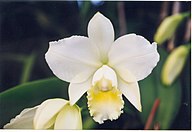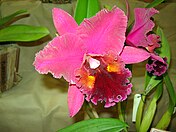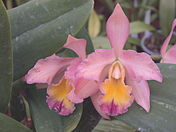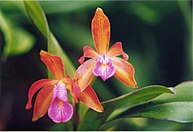Orchid
| Orchid Temporal range: Late Cretaceous – Recent
| |
|---|---|

| |
| Scientific classification | |
| Kingdom: | Plantae |
| Clade: | Tracheophytes |
| Clade: | Angiosperms |
| Clade: | Monocots |
| Order: | Asparagales |
| Family: | Orchidaceae Juss.[1] |
| Type genus | |
Tourn. ex L.
| |
| Subfamilies | |
| |

| |
| Distribution range of family Orchidaceae | |
Orchids are plants that belong to the
Orchidaceae is one of the two largest families of flowering plants, along with the Asteraceae. It contains about 28,000 currently accepted species distributed across 763 genera.[3][4]
The Orchidaceae family encompasses about 6–11% of all species of
Description
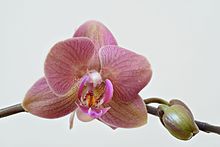
Orchids are easily distinguished from other plants, as they share some very evident derived characteristics or
Stem and roots
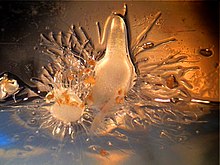
All orchids are
structure. They can grow according to two patterns:- Monopodial: The stem grows from a single bud, leaves are added from the apex each year, and the stem grows longer accordingly. The stem of orchids with a monopodial growth can reach several metres in length, as in Vanda and Vanilla.
- Sympodial: Sympodial orchids have a front (the newest growth) and a back (the oldest growth).[6] The plant produces a series of adjacent shoots, which grow to a certain size, bloom and then stop growing and are replaced. Sympodial orchids grow horizontally, rather than vertically, following the surface of their support. The growth continues by development of new leads, with their own leaves and roots, sprouting from or next to those of the previous year, as in Cattleya. While a new lead is developing, the rhizome may start its growth again from a so-called 'eye', an undeveloped bud, thereby branching. Sympodial orchids may have visible pseudobulbs joined by a rhizome, which creeps along the top or just beneath the soil.
Terrestrial orchids may be rhizomatous or form corms or tubers. The root caps of terrestrial orchids are smooth and white.
Some sympodial terrestrial orchids, such as
In warm and constantly humid climates, many terrestrial orchids do not need pseudobulbs.
Epiphytic orchids, those that grow upon a support, have modified aerial roots that can sometimes be a few meters long. In the older parts of the roots, a modified spongy epidermis, called a velamen, has the function of absorbing humidity. It is made of dead cells and can have a silvery-grey, white or brown appearance. In some orchids, the velamen includes spongy and fibrous bodies near the passage cells, called tilosomes.
The cells of the root epidermis grow at a right angle to the axis of the root to allow them to get a firm grasp on their support. Nutrients for epiphytic orchids mainly come from mineral dust, organic detritus, animal droppings and other substances collecting among on their supporting surfaces.
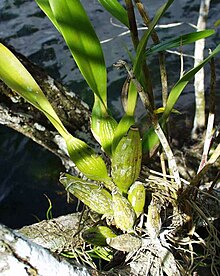
The base of the stem of sympodial epiphytes, or in some species essentially the entire stem, may be thickened to form a pseudobulb that contains nutrients and water for drier periods.
The pseudobulb typically has a smooth surface with lengthwise grooves, and can have different shapes, often conical or oblong. Its size is very variable; in some small species of Bulbophyllum, it is no longer than two millimeters, while in the largest orchid in the world, Grammatophyllum speciosum (giant orchid), it can reach three meters. Some Dendrobium species have long, canelike pseudobulbs with short, rounded leaves over the whole length; some other orchids have hidden or extremely small pseudobulbs, completely included inside the leaves.
With ageing the pseudobulb sheds its leaves and becomes dormant. At this stage it is often called a backbulb. Backbulbs still hold nutrition for the plant, but then a pseudobulb usually takes over, exploiting the last reserves accumulated in the backbulb, which eventually dies off, too. A pseudobulb typically lives for about five years. Orchids without noticeable pseudobulbs are also said to have growths, an individual component of a sympodial plant.
Leaves
Like most
The structure of the leaves corresponds to the specific habitat of the plant. Species that typically bask in sunlight, or grow on sites which can be occasionally very dry, have thick, leathery leaves and the
The leaves of most orchids are perennial, that is, they live for several years, while others, especially those with plicate leaves as in Catasetum, shed them annually and develop new leaves together with new pseudobulbs.
The leaves of some orchids are considered ornamental. The leaves of
Some orchids, such as
Orchids of the genus Corallorhiza (coralroot orchids) lack leaves altogether and instead wrap their roots around the roots of mature trees and use specialized fungi to harvest sugars.[7]
Flowers
Orchid flowers have three sepals, three petals and a three-chambered ovary. The three sepals and two of the petals are often similar to each other but one petal is usually highly modified, forming a "lip" or labellum. In most orchid genera, as the flower develops, it undergoes a twisting through 180°, called resupination, so that the labellum lies below the column. The labellum functions to attract insects, and in resupinate flowers, also acts as a landing stage, or sometimes a trap.[8][9][10][11]
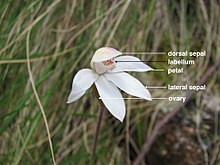
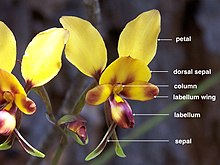
The reproductive parts of an orchid flower are unique in that the
Reproduction
Pollination
The complex mechanisms that orchids have evolved to achieve cross-pollination were investigated by Charles Darwin and described in Fertilisation of Orchids (1862). Orchids have developed highly specialized pollination systems, thus the chances of being pollinated are often scarce, so orchid flowers usually remain receptive for very long periods, rendering unpollinated flowers long-lasting in cultivation. Most orchids deliver pollen in a single mass. Each time pollination succeeds, thousands of ovules can be fertilized.
Pollinators are often visually attracted by the shape and colours of the labellum. However, some
In orchids that produce pollinia, pollination happens as some variant of the following sequence: when the pollinator enters into the flower, it touches a viscidium, which promptly sticks to its body, generally on the head or abdomen. While leaving the flower, it pulls the pollinium out of the anther, as it is connected to the viscidium by the caudicle or stipe. The caudicle then bends and the pollinium is moved forwards and downwards. When the pollinator enters another flower of the same species, the pollinium has taken such position that it will stick to the stigma of the second flower, just below the rostellum, pollinating it. In horticulture, artificial orchid pollination is achieved by removing the pollinia with a small instrument such as a toothpick from the pollen parent and transferring them to the seed parent.

Some orchids mainly or totally rely on self-pollination, especially in colder regions where pollinators are particularly rare. The caudicles may dry up if the flower has not been visited by any pollinator, and the pollinia then fall directly on the stigma. Otherwise, the anther may rotate and then enter the stigma cavity of the flower (as in Holcoglossum amesianum).
The slipper orchid Paphiopedilum parishii reproduces by self-fertilization. This occurs when the anther changes from a solid to a liquid state and directly contacts the stigma surface without the aid of any pollinating agent or floral assembly.[14]
The labellum of the Cypripedioideae is poke bonnet-shaped, and has the function of trapping visiting insects. The only exit leads to the anthers that deposit pollen on the visitor.
In some extremely specialized orchids, such as the Eurasian genus Ophrys, the labellum is adapted to have a colour, shape, and odour which attracts male insects via mimicry of a receptive female. Pollination happens as the insect attempts to mate with flowers.
Many neotropical orchids are pollinated by male orchid bees, which visit the flowers to gather volatile chemicals they require to synthesize pheromonal attractants. Males of such species as Euglossa imperialis or Eulaema meriana have been observed to leave their territories periodically to forage for aromatic compounds, such as cineole, to synthesize pheromone for attracting and mating with females.[15][16] Each type of orchid places the pollinia on a different body part of a different species of bee, so as to enforce proper cross-pollination.
A rare
Catasetum, a genus discussed briefly by Darwin, actually launches its viscid pollinia with explosive force when an insect touches a seta, knocking the pollinator off the flower.
After pollination, the sepals and petals fade and wilt, but they usually remain attached to the ovary.
In 2011, Bulbophyllum nocturnum was discovered to flower nocturnally.[17]
Asexual reproduction
Some species, such as in the genera Phalaenopsis, Dendrobium, and Vanda, produce offshoots or plantlets formed from one of the
Epipogium aphyllum exhibits a dual reproductive strategy, engaging in both sexual and asexual seed production. The likelihood of apomixis playing a substantial role in successful reproduction appears minimal. Within certain petite orchid species groups, there is a noteworthy preparation of female gametes for fertilization preceding the act of pollination. [19]
Fruits and seeds
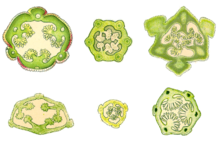
The ovary typically develops into a
The
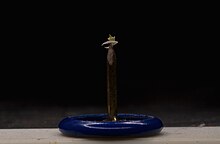
As the chance for a seed to meet a suitable fungus is very small, only a minute fraction of all the seeds released grow into adult plants. In cultivation, germination typically takes weeks.
Taxonomy
The
Five
| |||||||||||||||||||||||||
In 2015, a
Evolution
A study in the scientific journal
Genetic sequencing indicates orchids may have arisen earlier, 76 to 84 million years ago during the
Using the
Genome duplication occurred prior to the divergence of this taxon.[29]
Genera
There are around 800 genera of orchids. The following are amongst the most notable genera of the orchid family:[30]
- Aa
- Abdominea
- Acampe
- Acanthophippium
- Aceratorchis
- Acianthus
- Acineta
- Acrorchis
- Ada
- Aerangis
- Aeranthes
- Aerides
- Aganisia
- Agrostophyllum
- Anacamptis
- Ancistrochilus
- Angraecum
- Anguloa
- Ansellia
- Aorchis
- Aplectrum
- Arachnis
- Arethusa
- Armodorum
- Ascoglossum
- Australorchis
- Auxopus
- Barkeria
- Bartholina
- Beloglottis
- Biermannia
- Bletilla
- Brassavola
- Brassia
- Bulbophyllum
- Calanthe
- Calypso
- Catasetum
- Cattleya
- Chiloschista
- Cirrhopetalum
- Cleisostoma
- Clowesia
- Coelogyne
- Coryanthes
- Cycnoches
- Cymbidium
- Cyrtopodium
- Cypripedium
- Dactylorhiza
- Dendrobium
- Disa
- Dracula
- Encyclia
- Epidendrum
- Epipactis
- Eria
- Eulophia
- Gastrochilus
- Gongora
- Goodyera
- Grammatophyllum
- Gymnadenia
- Habenaria
- Herschelia
- Ionopsis
- Laelia
- Lepanthes
- Liparis
- Ludisia
- Lycaste
- Masdevallia
- Maxillaria
- Meliorchis
- Mexipedium
- Miltonia
- Mormodes
- Odontoglossum
- Oeceoclades
- Oncidium
- Ophrys
- Orchis
- Paphiopedilum
- Papilionanthe
- Paraphalaenopsis
- Peristeria
- Phaius
- Phalaenopsis
- Pholidota
- Phragmipedium
- Platanthera
- Platystele
- Pleione
- Pleurothallis
- Pomatocalpa
- Promenaea
- Pterostylis
- Renanthera
- Restrepia
- Restrepiella
- Rhynchostylis
- Roezliella
- Saccolabium
- Sarcochilus
- Satyrium
- Seidenfadenia
- Selenipedium
- Serapias
- Sobralia
- Spiranthes
- Stanhopea
- Stelis
- Thrixspermum
- Tolumnia
- Trias
- Trichocentrum
- Trichoglottis
- Vanda
- Vanilla
- Yoania
- Zeuxine
- Zygopetalum
Etymology
The
In Middle English, the name bollockwort was used for some orchids, based on "bollock" meaning testicle and "wort" meaning plant.[36]
Hybrids
Orchid species hybridize readily in cultivation, leading to a large number of hybrids with complex naming. Hybridization is possible across genera, and therefore many cultivated orchids are placed into nothogenera. For instance, the nothogenus × Brassocattleya is used for all hybrids of species from the genera Brassavola and Cattleya. Nothogenera based on at least three genera may have names based on a person's name with the suffix -ara, for instance × Colmanara = Miltonia × Odontoglossum × Oncidium. (The suffix is obligatory starting at four genera.[37])
Cultivated hybrids in the orchid family are also special in that they are named by using grex nomenclature, rather than nothospecies. For instance, hybrids between Brassavola nodosa and Brassavola acaulis are placed in the grex Brassavola Guiseppi.[38] The name of the grex ("Guiseppi" in this example) is written in a non-italic font without quotes.[39]
Abbreviations
As a unique feature of the orchid family, a system of abbreviations exists that applies to names of genera and nothogenera. The system is maintained by the Royal Horticultural Society.[40] These abbreviations consist of at least one character, but may be longer. As opposed to the usual one-letter abbreviations used for names of genera, orchid abbreviations uniquely determine the (notho)genus. They are widely used in cultivation. Examples are Phal for Phalaenopsis, V for Vanda and Cleis for Cleisostoma.
Distribution
Orchidaceae are
The following list gives a rough overview of their distribution:[citation needed]
- Oceania: 50 to 70 genera
- North America: 20 to 26 genera
- tropical America: 212 to 250 genera
- tropical Asia: 260 to 300 genera
- tropical Africa: 230 to 270 genera
- Europe and temperate Asia: 40 to 60 genera
Ecology
A majority of orchids are
Some orchids, such as
Uses
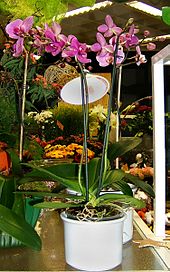
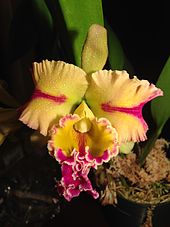
Perfumery
The
Horticulture
The other important use of orchids is their cultivation for the enjoyment of the flowers. Most cultivated orchids are tropical or subtropical, but quite a few that grow in colder climates can be found on the market. Temperate species available at nurseries include Ophrys apifera (bee orchid), Gymnadenia conopsea (fragrant orchid), Anacamptis pyramidalis (pyramidal orchid) and Dactylorhiza fuchsii (common spotted orchid).
Orchids of all types have also often been sought by collectors of both species and hybrids. Many hundreds of societies and clubs worldwide have been established. These can be small, local clubs, or larger, national organisations such as the American Orchid Society. Both serve to encourage cultivation and collection of orchids, but some go further by concentrating on conservation or research.
The term "botanical orchid" loosely denotes those small-flowered, tropical orchids belonging to several genera that do not fit into the "florist" orchid category. A few of these genera contain enormous numbers of species. Some, such as Pleurothallis and Bulbophyllum, contain approximately 1700 and 2000 species, respectively, and are often extremely vegetatively diverse. The primary use of the term is among orchid hobbyists wishing to describe unusual species they grow, though it is also used to distinguish naturally occurring orchid species from horticulturally created hybrids.
New orchids are registered with the International Orchid Register, maintained by the Royal Horticultural Society.[47]
Food
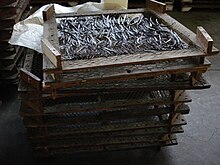
The dried seed pods of one orchid genus, Vanilla (especially Vanilla planifolia), are commercially important as a flavouring in baking, for perfume manufacture and aromatherapy.
The underground tubers of terrestrial orchids [mainly Orchis mascula (early purple orchid)] are ground to a powder and used for cooking, such as in the hot beverage salep or in the Turkish mastic ice cream dondurma. The name salep has been claimed to come from the Arabic expression ḥasyu al-tha‘lab, "fox testicles", but it appears more likely the name comes directly from the Arabic name saḥlab. The similarity in appearance to testes naturally accounts for salep being considered an aphrodisiac.
The dried leaves of
Some saprophytic orchid species of the group Gastrodia produce potato-like tubers and were consumed as food by native peoples in Australia and can be successfully cultivated, notably Gastrodia sesamoides. Wild stands of these plants can still be found in the same areas as early Aboriginal settlements, such as Ku-ring-gai Chase National Park in Australia. Aboriginal peoples located the plants in habitat by observing where bandicoots had scratched in search of the tubers after detecting the plants underground by scent.[note 1]
Cultural symbolism
Orchids have many associations with symbolic values. For example, the orchid is the City Flower of Shaoxing, China. Cattleya mossiae is the national Venezuelan flower, while Cattleya trianae is the national flower of Colombia. Vanda Miss Joaquim is the national flower of Singapore, Guarianthe skinneri is the national flower of Costa Rica and Rhyncholaelia digbyana is the national flower of Honduras.[49] Prosthechea cochleata is the national flower of Belize, where it is known as the black orchid.[50] Lycaste skinneri has a white variety (alba) that is the national flower of Guatemala, commonly known as Monja Blanca (White Nun). Panama's national flower is the Holy Ghost orchid (Peristeria elata), or 'the flor del Espiritu Santo'. Rhynchostylis retusa is the state flower of the Indian state of Assam where it is known as Kopou Phul.[51]
Orchids native to the Mediterranean are depicted on the Ara Pacis in Rome, until now the only known instance of orchids in ancient art, and the earliest in European art.[note 2] A French writer and agronomist, Louis Liger, invented a classical myth in his book Le Jardinier Fleuriste et Historiographe published in 1704, attributing it to the ancient Greeks and Romans, in which Orchis the son of a nymph and a satyr rapes a priestess of Bacchus during one of his festivals the Bacchanalia and is then killed and transformed into an orchid flower as punishment by the gods, paralleling the various myths of youths dying and becoming flowers, like Adonis and Narcisuss; this myth however does not appear any earlier than Liger, and is not part of traditional Greek and Roman mythologies.[53]
- Some cultivars
-
Cattleya Mrs. Mahler 'Mem. Fred Tompkins'
-
Cattleya Queen Sirikit 'Diamond Crown'
-
Cattleya Hawaiian Wedding Song 'Virgin'
-
Rhyncholaeliocattleya Chia Lin
-
Cattleya Hawaiian Variable 'Prasan'
-
Cattlianthe Barbara Belle
-
Cattleya Beaumesnil 'Parme'
-
Cattlianthe Chocolate Drop x Cattleya Pão de Açúcar
-
Cattleya mossiae 'Empress Frederick'
-
'Hermine'
-
Cattleya Little Angel
-
Cattleya Marjorie Hausermann 'York'
-
'Miva Breeze Alize'
-
Rhyncholaeliocattleya 'Nobile's carnival'
-
Cattleya Pernel George Barnett 'Yankee Clipper'
-
Cattlianthe Portia
Conservation
Almost all orchids are included in Appendix II of the Convention on International Trade in Endangered Species (CITES), meaning that international trade (including in their parts/derivatives) is regulated by the CITES permit system.[54] A smaller number of orchids such as Paphiopedilum sp. are listed in CITES Appendix I meaning that commercial international trade in wild-sourced specimens is prohibited and all other trade is strictly controlled.[54]
Assisted migration as conservation tool
In 2006 the
See also
- Adaptation (film), based on The Orchid Thief
- Orchid Conservation Coalition
- Orchid Pavilion Gathering
- Orchidelirium, the Victorian era of flower madness in which collecting and discovering orchids reached extraordinary levels
- Orchids of the Philippines
- Orchids of Western Australia
- Shangsi Festival
- Black rot on orchids
- List of taxa named after human genitals
Notes
References
- ^ hdl:10654/18083.
- ^ Gove, Philip B., ed. (1961). Webster's Third New International Dictionary. G. & C. Merriam.
- .
- ^ "WCSP". World Checklist of Selected Plant Families. Retrieved 2 April 2010. (See External links below).
- S2CID 30157588.
- ^ Nash, N., and Frownie, S. (2008). Complete guide to orchids. (Meredith Publishing Group) p. 12.
- ^ Jenny King (10 June 2011). "The coralroot orchid". Orchids in Northern Washington State. Silvercrown Mountain Outdoor School. Archived from the original on 21 October 2011. Retrieved 10 June 2011.
- ^ ISBN 9780646562322.
- ^ ISBN 9780980348149.
- ^ a b c "Structure of orchid flowers". New Zealand Plant Conservation Network. Retrieved 15 April 2022.
- ^ a b c Zimmermann, Pedro. "Anatomy of an Orchid". Brasilian Orchid Organisation. Retrieved 15 April 2022.
- ^ Carr, Gerald (30 October 2005). "Flowering Plant Families". Vascular Plant Family. University of Hawaii Botany Department. Retrieved 3 August 2022.
- S2CID 24971928., 28:1161-1172 and 31(3): 509-519.
- PMID 22649529.
- S2CID 53161684.
- S2CID 20819411.
- ^ Tom Lawrie (23 November 2010). "World's first night-flowering orchid discovered". Australian Geographic. Archived from the original on 30 November 2011. Retrieved 26 May 2013.
- ^ Matthew Blanchard, Roberto Lopez, Erik Runkle, PhD, and Yin-Tung Wang, PhD "Growing the Best Phalaenopsis", WWW.AOS.ORG ORCHIDS APRIL 2007 Archived June 27, 2010, at the Wayback Machine
- PMID 27288512.
- ^ Thompson, David Ian (2003). Conservation of select South African Disa Berg. Species (Orchidaceae) through in vitro seed germination. University of Natal.
- S2CID 41321812.
- PMID 25345817.
- PMID 26311671.
- ^ S2CID 4402181.
- .
- ^ "An overview of the Phalaenopsis orchid genome by BAC sequence analysis" (pdf format) Archived 20 March 2014 at the Wayback Machine.
- ISBN 978-0-19-850710-9.
- ^ PMID 38382573.
- PMID 28902843.
- ^ "Orchidaceae - an overview | ScienceDirect Topics". www.sciencedirect.com. Retrieved 15 June 2023.
- ISBN 978-84-249-1332-8.
- ISBN 978-0-19-866189-4.
- ^ Liddell, Henry George; Scott, Robert (1940). "ὄρχις". A Greek-English Lexicon. Perseus Digital Library.
- ^ Online Etymology Dictionary, "orchid".
- ISBN 978-0-7139-0442-0.
- ^ "bollock, n. and adj". Oxford English Dictionary. Retrieved 19 January 2018.
- ^ International Code of Nomenclature for Cultivated Plants 9th edition (2016), Article H.6 and H.7.
- ^ Brassavola Guiseppi Casa Luna 1968, BlueNanta.
- ^ International Code of Nomenclature for Cultivated Plants 9th edition, 2016.
- ^ "Alphabetical List of Standard Abbreviations for Natural and Hybrid Generic Names" (PDF).
- .
- .
- ISSN 1742-9145.
- S2CID 86046305.
- S2CID 59939679.
- PMID 26886766.
- ^ RHS 2016.
- ISBN 978-1-875606-10-8.
- ^ "Simbolos Patrios" (in Spanish). Retrieved 22 June 2008.
- ^ "National Symbols". Government of Belize. Archived from the original on 12 October 2007. Retrieved 6 April 2008.
- ^ "List of Assam State Symbols | State Animal| State Flower | State Tree". assamyellowpage.com. 1 March 2012. Retrieved 14 May 2019.
- ^ Lobelli, Jarrett A. (2012). "The Emperor's orchids". Archaeology. 66 (1): 16. Archived from the original on 17 December 2012.
- ISBN 978-0-226-37632-5.
- ^ a b The CITES Appendices, CITES, archived from the original on 14 April 2012, retrieved 16 April 2012
- ISSN 0006-3207.
Bibliography
- RHS (2016). "Search The International Orchid Register". Royal Horticultural Society. Retrieved 28 November 2017.
Documentaries
- 2017: Hidden Beauty – The Orchids of the Saale Valley, directed by David Cebulla
External links
- Citizen science observations for Orchidaceae at iNaturalist
- "Orchidaceae". The Plant List. Missouri Botanical Garden. Royal Botanic Gardens, Kew.
{{cite web}}: CS1 maint: others (link) Note that this website has been superseded by World Flora Online - Orchidaceae at the Angiosperm Phylogeny Website
- World checklist of Orchidaceae species from the Catalogue of Life, 29,572 species supplied by World Checklist of Selected Plant Families (R. Govaerts & al.)
- Flora of North America Editorial Committee (ed.). "Orchidaceae". Flora of North America North of Mexico (FNA). New York and Oxford: Oxford University Press – via eFloras.org, Missouri Botanical Garden, St. Louis, MO & Harvard University Herbaria, Cambridge, MA.
- "Orchidaceae". Flora of China – via eFloras.org, Missouri Botanical Garden, St. Louis, MO & Harvard University Herbaria, Cambridge, MA.
- Orchidaceae at the online Flora of Zimbabwe
- Orchidaceae at the online Flora of the Western Australian
- Orchidaceae at the online Flora of New Zealand
- The Global Orchid Information Network
- Orchid Conservation Coalition



